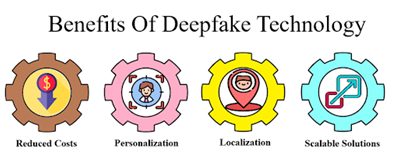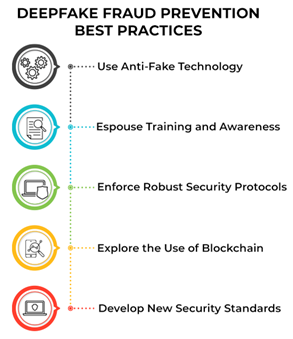AI-Generated Synthetic Media (Deep Fake Technology)
Context: A “deepfake” is a fake video or audio where someone’s face or voice is replaced with someone else’s using technology.
How does a deepfake technology work?
A deepfake video uses two computer models.
One makes fake videos from a set of real ones, and the other checks if the video is fake. When the second model can’t spot the fake, it’s likely to fool humans too. This method is called “generative adversarial network (GAN).”
Types of Deepfake Technology:

- Face-swapping: This is the most common type, where one person’s face is replaced with another’s in a video.
- Voice cloning: Deepfake technology can mimic someone’s voice to create fake audio recordings.
- Text generation: Deep learning models can generate fake text that mimics a specific writing style or content.
- Image manipulation: Deepfakes can alter images to create fake scenes or modify the appearance of objects.
- Video manipulation: Beyond face-swapping, deepfakes can alter the entire video, changing actions and scenes.
- Audio-visual deepfakes: These combine face-swapping and voice cloning to create highly convincing fake videos.
Benefits of Deepfake Technology:

Cost Reduction:
- Deepfake technology significantly reduces video production costs.
- Traditional expenses on equipment, studios, and actors are eliminated.
- Allows for budget-friendly and efficient video creation.
Localization:
- Enables speakers to communicate in multiple languages without dubbing or license fees.
- Actor identity licenses facilitate content creation in various languages.
- Expands reach and accessibility to diverse audiences.
Personalization:
- Empowers brands to create highly personalized consumer experiences.
- Enables swapping of faces in videos for tailored demonstrations.
- Studies show personalized experiences enhance consumer engagement and boost purchasing likelihood.
Scaled Solutions:
- Facilitates personalized marketing at scale.
- Deepfake technology fetches specific parameters from CRM lists, such as names and designations.
- Enables the creation of individualized video content for email campaigns.
- Enhances customer engagement through tailored and personalized communication.
Effects of Deepfake Technology:
Deepfake Pornography:
- Over 96% of deepfakes are pornographic, with millions of views on adult websites.
- Primarily targets women, causing emotional distress, psychological harm, and potential financial and job-related consequences.
Tarnishing Individual Image:
- Deepfakes can portray individuals engaging in false and damaging behaviours.
- Even if victims can prove the content is fake, the initial harm is often already done.
Social Harm:
- Deepfakes contribute to a decline in trust in traditional media.
- They can lead to a culture of factual relativism, straining civil society.
Threat to Public Safety:
Malicious nation-states can use deepfakes to create uncertainty and chaos, undermining public safety and trust in institutions.
Use by Terrorist Organizations:
Non-state actors like insurgent groups and terrorists can employ deepfakes to manipulate public sentiment against their adversaries.
Promotion of Fake News:
- Deepfakes can lead to the dismissal of actual truths as fake news or deepfakes.
- Leaders may use deepfakes and fake news to manipulate narratives and deny reality.
Liar’s Dividend:
Deepfakes can lead to dismissing undesirable truths as fake, allowing public figures to hide their immoral acts.
Privacy Violation:
Misusing content from social media platforms to create deepfakes violates individuals’ right to privacy.
Blackmail Tool:
Deepfakes can be used for extortion, extracting money, confidential information, or favours from individuals.
Reputation Damage:
- Deepfakes can portray individuals engaging in negative behaviours and saying harmful things.
- This can severely damage their reputation, affecting personal and professional life.
Legal protection available in India
IPC & IT Act:
Section 500 of the IPC provides punishment for defamation.
Sections 67 and 67A of the Information Technology Act punish sexually explicit material in explicit form.
RPI:
The Representation of the People Act, 1951, includes provisions prohibiting the creation or distribution of false or misleading information about candidates or political parties during an election period.
ECI Guidelines:
The Election Commission of India has set rules that require registered political parties and candidates to get pre-approval for all political advertisements on electronic media, including TV and social media sites, to help ensure their accuracy and fairness.

Best Practices:
China’s new regulations on “deepfakes”:
- Effective Date: Starting from January 10, 2023, these regulations are enforced by the Cyberspace Administration of China (CAC).
- Official Title: They are officially known as ‘The Administrative Provisions on Deep Synthesis for Internet Information Services’ and aim to address concerns about potential misuse of AI technology
- Consent Required: Deepfakes must not be created or used without the consent of the individuals depicted.
- Protecting National Interests: These rules prevent the creation of deepfakes that could harm the national interest.
Practice Bits:
Consider the following statements regarding Deepfakes
- These are modified images, text, audio, and video or synthetic media, created with the help of Artificial Intelligence.
- The existence of deep fakes causes much distrust among the public that any true evidence of a crime can easily be dismissed as fake.
- The existing legal framework in India criminalize deep fakes.
Which of the above statements is/are correct?
- a) 1 and 2 only
- b) 2 and 3 only
- c) 1 and 3 only
- d) 1, 2 and 3
Consider the following statements regarding deepfakes:
- The deep fakes are a compilation of artificial images and audio put together with machine-learning algorithms.
- It uses deep learning technology to generate text, images, audio and video scenes.
- It can create people who do not exist and it can fake real people saying and doing things they did not say or do.
Which of the statements given above is /are correct?
- a) 1 only
- b) 1 and 2 only
- c) 2 and 3 only
- d) 1, 2 and 3
Mains Practice Questions:
- Deepfakes: A Double-Edged Sword in the Digital Era. Comment.
- Deepfakes are one example of the constantly changing, extremely complex risks that technology poses. Discuss.


